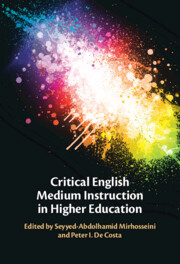Book contents
- Critical English Medium Instruction in Higher Education
- Critical English Medium Instruction in Higher Education
- Copyright page
- Contents
- Figures and Tables
- Contributors
- Foreword
- 1 Critical Views of English Medium Instruction
- Part I Ideologies and Educational Policies
- 2 Conceptualisations of English in an Italian EMI Context
- 3 Ideologies of Language Use in an EMI University in Hong Kong
- 4 Burdening EMI with Unnecessary Baggage
- 5 Entrepreneurial Orientations towards Language and Education
- 6 A Critical Approach to the Rise of EMI
- Part II Identity and Educational Justice
- Part III The Politics of English in Education
- Afterword
- Index
- References
6 - A Critical Approach to the Rise of EMI
Why, How, and by Whom Are Decisions Made?*
from Part I - Ideologies and Educational Policies
Published online by Cambridge University Press: 31 January 2025
- Critical English Medium Instruction in Higher Education
- Critical English Medium Instruction in Higher Education
- Copyright page
- Contents
- Figures and Tables
- Contributors
- Foreword
- 1 Critical Views of English Medium Instruction
- Part I Ideologies and Educational Policies
- 2 Conceptualisations of English in an Italian EMI Context
- 3 Ideologies of Language Use in an EMI University in Hong Kong
- 4 Burdening EMI with Unnecessary Baggage
- 5 Entrepreneurial Orientations towards Language and Education
- 6 A Critical Approach to the Rise of EMI
- Part II Identity and Educational Justice
- Part III The Politics of English in Education
- Afterword
- Index
- References
Summary
English as a Medium of Instruction (EMI) is linked with power and dominance; however, what Critical EMI might look like requires further clarification and illustration. In this chapter we offer one such example of a critical approach to EMI by presenting emerging findings from our project, ELEMENTAL – English as the Language-of-Education Mechanisms in Europe: New Transdisciplinary Approaches in Linguistics. ELEMENTAL borrows tools and concepts from political science to re-theorise the rise of EMI in European higher education (HE) as linked to governance reforms that have sought to deregulate the market and grant higher education institutions (HEIs) greater autonomy. While this so-called steering at a distance mode of governance differs in form and extent across Europe, it typically relies on steering tools such as key performance indicators, competitive funding formulae, institutional profiling, strategic development plans and other means of incentivising HEIs to enhance their performance. Presenting evidence from Turkish HE, we argue that steering at a distance may have played a role in paving the way for EMI or, at the very least, created a climate in which it can emerge and thrive. We conclude by considering the potential of transdisciplinarity as a way forward for a Critical EMI.
- Type
- Chapter
- Information
- Critical English Medium Instruction in Higher Education , pp. 87 - 104Publisher: Cambridge University PressPrint publication year: 2025

